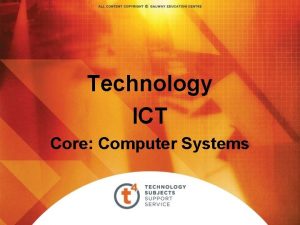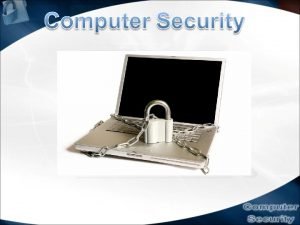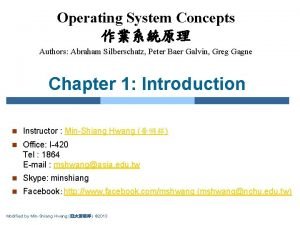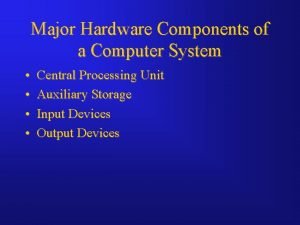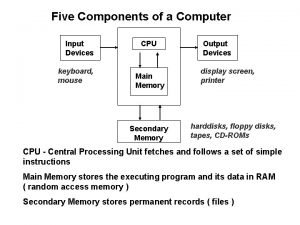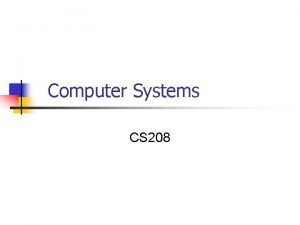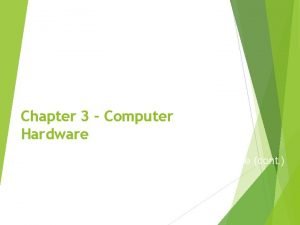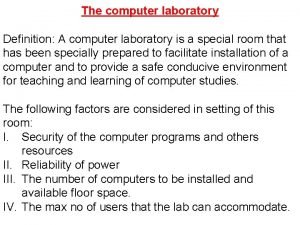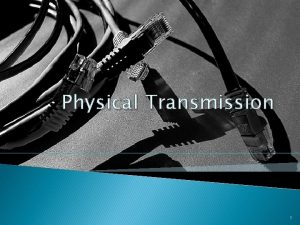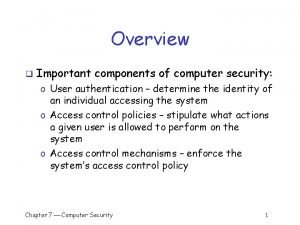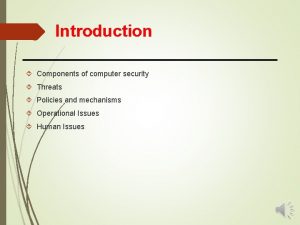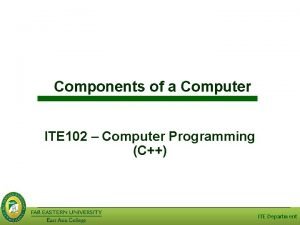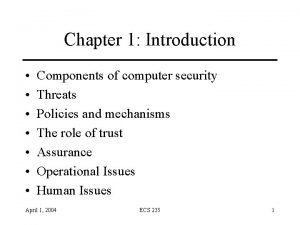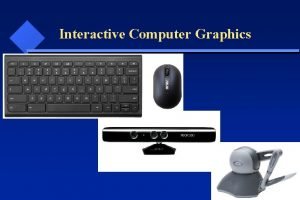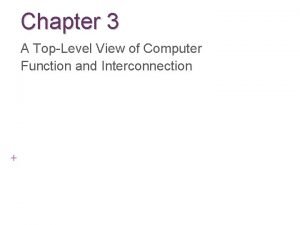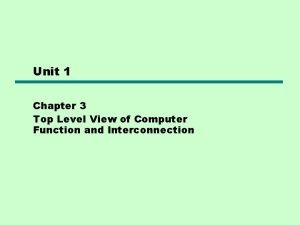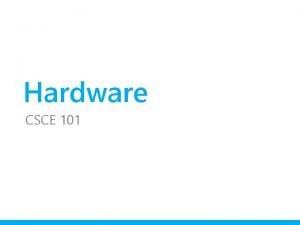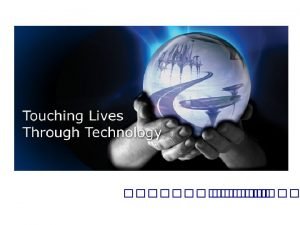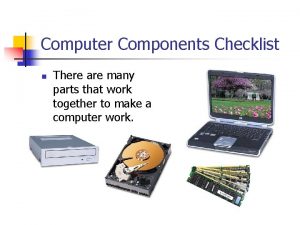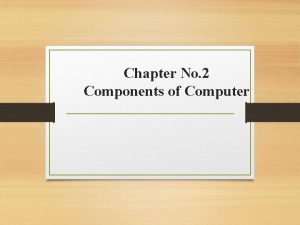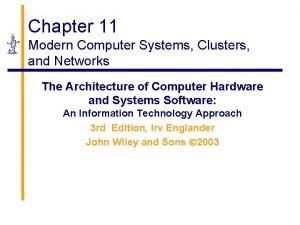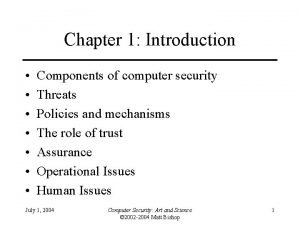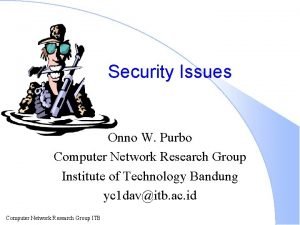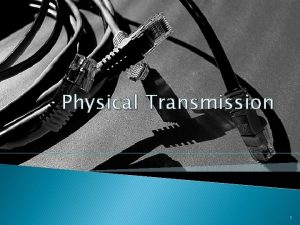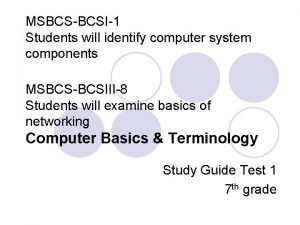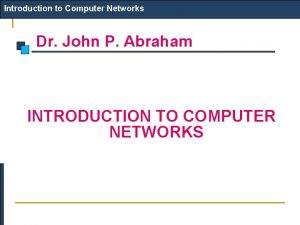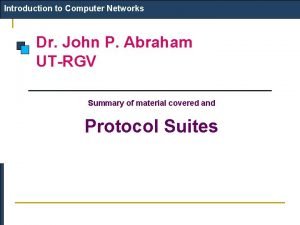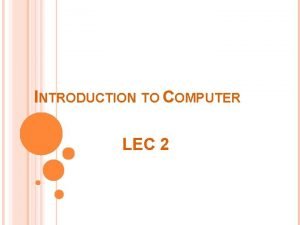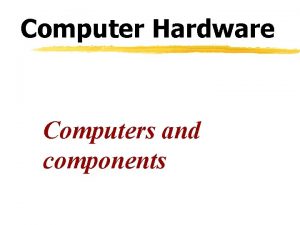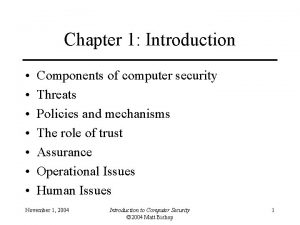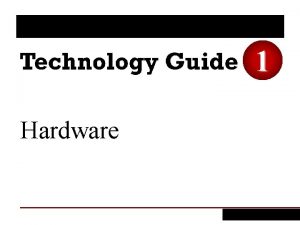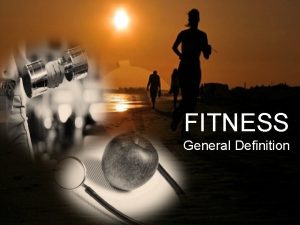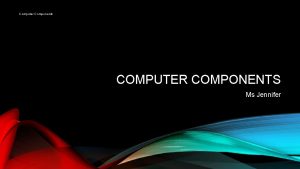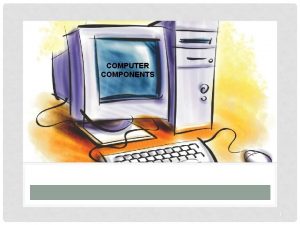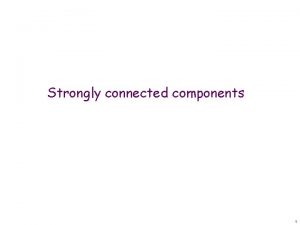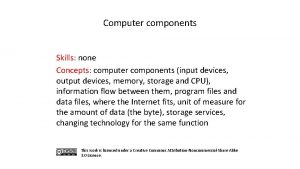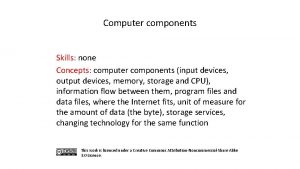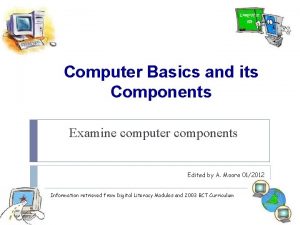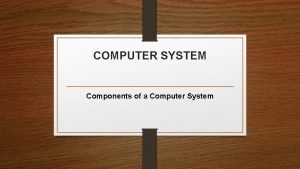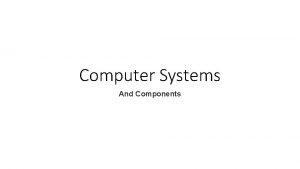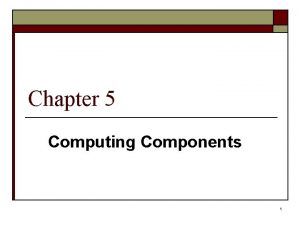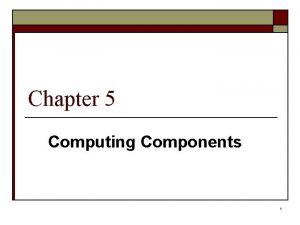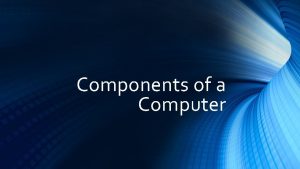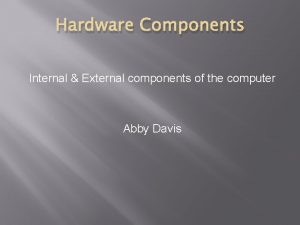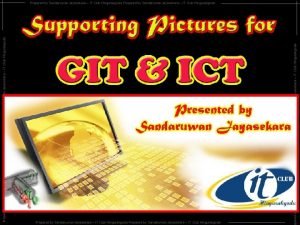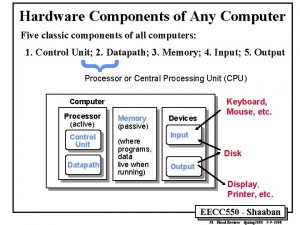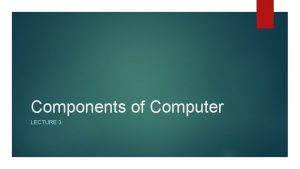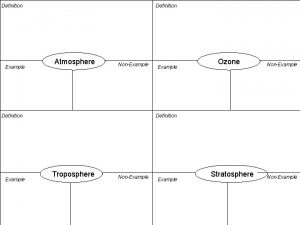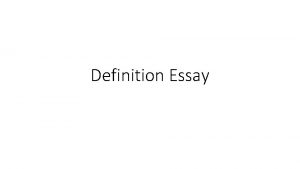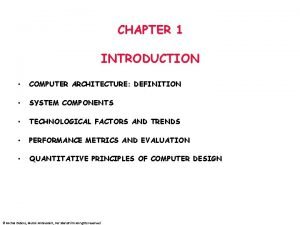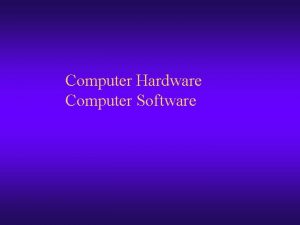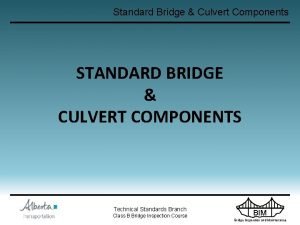COMPUTER COMPONENTS 1 COMPUTER DEFINITION A computer is








































- Slides: 40

COMPUTER COMPONENTS 1

COMPUTER DEFINITION • A computer is a machine that is used to store and process data electronically 2

A COMPUTER SYSTEM • Hardware • Software • User Software Hardware 3

A COMPUTER SYSTEM (CONTD. ) • In general, a computer is a machine which accepts data, processes it and returns new information as output. Processing Data Information 4

memor y Brain 3 1+2 5

Memory CPU 3 Output devices 1+2 Computer Input devices 6

Computer components Software Hardware 7

HARDWARE • Pieces of equipment that make up a computer system. • These are the parts you can touch (although many parts are contained within the computer’s case). 8

EXAMPLE OF COMPUTER SPECIFICATION 9

Computer hardware Storage Devices Output devices Input devices memory Central Processing Unit CPU 10

THE CENTRAL PROCESSING UNIT (CPU) The brains of the computer All the "thinking", calculating and processing is done by the CPU. The CPU also control the transfer of information between the secondary and main memory The speed at which CPU can process information is Known as its Clock Speed 11

THE CENTRAL PROCESSING UNIT (CPU) This is measured in megahertz (MHz) or gigahertz (GHz). 1 megahertz = 1 million cycles per second. 1 gigahertz = 1000 megahertz. The CPU also incorporates an Arithmetic and Logic Unit (which performs the calculations and logical operations within the computer) Control Unit (which fetches, decodes and executes data from the memory). 12

Memory (RAM) (ROM) 13

RAM (RANDOM ACCESS MEMORY) OR MAIN MEMORY Random access memory is used in a PC to temporarily store data when you are using applications. RAM is also used to store program instructions and feed information to the CPU to process. RAM is not permanent, when you switch off the PC (or shut down), the contents of RAM are lost or emptied This is known as volatile memory. 14

ROM (READ ONLY MEMORY) • This is a special type of memory which contains all the information the computer needs to switch itself on, check that all its systems are working and to tell the PC what things are plugged into it. • Data stored cannot be changed or overwritten by you, and stays the same even when the PC is switched off. 15

LANGUAGE OF COMPUTERS • Computers only understand the electronic signals. Either Current is flowing or not. • Current Flowing : ON • Current Not Flowing : OFF • Binary Language • ON : 1 • OFF : 0 • Bit, Byte, KB, MB, GB 16

THE INFORMATION STORAGE UNIT 1 1 0 0 1 1 A Bit Byte 17

bit the amount of storage space needed to hold either a 1 or a 0 in memory (binary numbering ) This is the smallest unit of computer memory byte Equal to 8 bits , this is the amount of storage space needed to hold one character Kilobyte(KB) bytes 1024 Megabyte(MB) 1024 KB Gigabyte(GB) 1024 MB THE INFORMATION STORAGE UNIT Terabyte(TB) 1024 GB 18

INPUT DEVICES • An input device is any device that is used to supply information to a computer (as data or for the selection of commands/menus/icons etc) 19

EXAMPLES 20

OUTPUT DEVICES Any devices that allows the result of computer processing activity to be seen or heard Printer Plotter 21

OUTPUT DEVICE: SCREEN q. CRT q. LCD q. Plasma 22

OUTPUT DEVICE Data. Show Speaker 23

Computer hardware Storage device Output devices Input devices memory Central Processing Unit 24

STORAGE DRIVES • Storage drives are used to store and transfer data files. • After data is entered into a computer, it must be saved as a file to preserve its contents after the computer is switched off. 25

HARD DISK drive HDD Usually fixed inside the computer and stores large volumes of data, which can be accessed and retrieved quickly. A software application must also install files onto the hard disk drive in order to run. the access time of a HDD is measured in milliseconds(msec) 26

Floppy disk drive: A floppy disk drive is like a hard disk, but with removable disks called floppies, floppy disks or diskettes. Floppies can be used to transfer small files from one PC to another (up to 1. 4 MB) CD-ROM/DVD-ROM Drive: CD-ROM (Compact Disk – Read Only Memory) CD-ROM -> CD-RW -> DVD-R 27

Computer components Software Hardware 28

SOFTWARE • Software is set of programs (which are step by step instructions) telling the computer how to process data. • Software needs to be installed on a computer, usually from a CD. • Software's can be divided into two groups: - System SW - Application SW 29

SOFTWARE (CONTD. ) System Software It controls the overall operation of the system. It is stored in the computer's memory and instructs the computer to load, store, and execute an application. Examples: Operating System (OS), Translators DOS, Microsoft Windows , Unix, Linux, OS 2, Be. OS, OS-X (Mac OS) and so on Operating system cannot run without the BIOS 30

SOFTWARE (CONTD. . ) Application Software • They are Software's written to perform specific tasks. • The basic types of application software are: word processing, database, spreadsheet, desktop publishing, and communication. Examples: MSOffice, MSOutlook, BANKSOFT 31

APPLICATION SOFTWARE • Applications Software must be compatible with the Operating Systems • Common Applications Software: • Word Processing as Microsoft Word • Spreadsheets as Microsoft Excel • Database as Microsoft Access • Presentation as Microsoft Power. Point • Web browsing as Internet Explorer 32

Sara Turn on her computer and then open the word processor to write her homework What are the steps taken by the computer to do this task in order ? 4 1 3 2 Load MS word in to the RAM Run the BIOS software from the ROM read the OS files from HDD and copy them to the RAM the BIOS crries out the Power On Self Test(POST) 33

TYPES OF COMPUTER 34

TYPES OF COMPUTERS Computer Types can be divided depends on : • Size • Way of work 35

Super computers Mainframes Depends on its size Minicomputers Microcomputers Workstations Types of computers Control Computers Digital Computers Depends on its way of work Analog Computers Hybrid Computer 36

COMPUTER NETWORK • A Computer Network is interconnection of Computers to share resources. • Resources can be : Information, Load, Devices etc. 37

TYPES OF COMPUTER NETWORKS • On the basis of Size: LAN WAN Its a network of the computers locally Its a network of the computers spread widely geographically. one room, one building In a few buildings , city , country , over many countries. 38

BENEFITS OF COMPUTER NETWORKS • Information Sharing • Device Sharing • Load Sharing • Mobility • Fast Communication • Anywhere Anytime Banking 39

INTERNET • Internet is a huge network of computer networks. • Internet provides many services: • • Email World Wide Web (www) Remote Login (Telnet) File Transfer (FTP) • Intranet is the generic term for a collection of private computer networks within an organization. 40
 Define components of computer
Define components of computer Computer technology
Computer technology Basic components of security
Basic components of security Interrupt timeline
Interrupt timeline Parts of computer
Parts of computer 0110100101
0110100101 Three major components of computer system
Three major components of computer system Five components of computer
Five components of computer Major components of computer system
Major components of computer system 3 basic components of computer
3 basic components of computer A computer laboratory can be defined as
A computer laboratory can be defined as What are software components
What are software components Components of computer network
Components of computer network Components of computer security
Components of computer security Https://www.naturalnews.com wikipedia
Https://www.naturalnews.com wikipedia Computerite
Computerite Components of computer security
Components of computer security Usemapevents
Usemapevents Basic components of computer security
Basic components of computer security Computer components top level view
Computer components top level view Computer components top level view
Computer components top level view Contains the central electronic components of the computer
Contains the central electronic components of the computer Tangible parts of the computer
Tangible parts of the computer Basic components of computer
Basic components of computer Computer components
Computer components 2 components of computer
2 components of computer Computer systems components
Computer systems components Components of computer security
Components of computer security Components of computer security
Components of computer security Computer components: top-level view
Computer components: top-level view Components of computer network
Components of computer network Components of computer network
Components of computer network Components of computer network
Components of computer network Components of computer network
Components of computer network Abraham ethernet
Abraham ethernet Components of digital computer
Components of digital computer Components of computer
Components of computer Components of computer security
Components of computer security Components of computer security
Components of computer security Hardware identify
Hardware identify Components of fitness definition
Components of fitness definition

